1.
It’s been a week since the first night of Passover, but I’m still stuck on that Seder brisket. Seder is the ritual feast that marks the first day of the Passover holiday and the consideration of the important things in one’s life: family, tradition, and spirituality. The beauty of tradition is the takeaway; each family has its own traditions, and anyone can start a new one. What is perhaps more unique about cultural traditions is the nuance that Americans interject. For kids and grandkids of immigrants, a blending of old world and new school takes form. The Passover Seder is no different. At the one I attend with my wife, we have brisket and kugel. We toast vintage wine during an abridged version of the Haggadah, because this is how it’s done.
The recipe for the brisket is the conversation between blessings and drinks. How long was it cooked, how was it marinated, who made the best one and so on. Brisket is considered the dish for Jewish holidays. Imagine that slow cooked smell permeating the kitchen: what is there not to like?
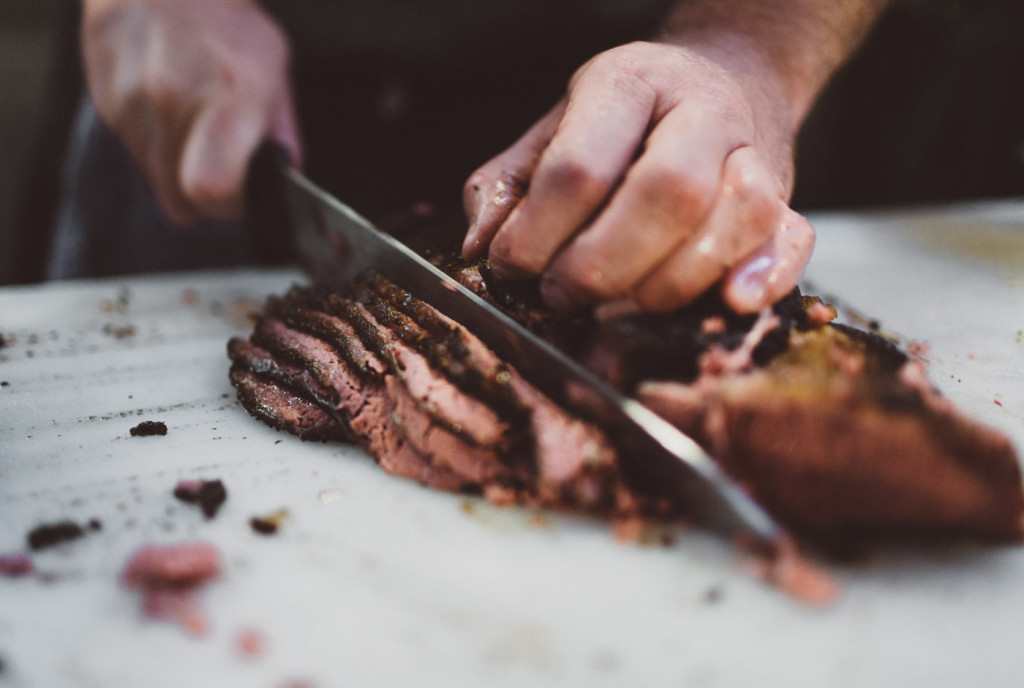
Brisket has a long history in the United States. Tracing it back to the turn of the century when ethnic groups lived more-or-less in enclaves and bought from the neighborhood butcher, the meat is traditionally a cheaper cut. Preserving the meat in a brine prolonged shelf life, and what came from curing the meat is what we now know as pastrami.
Pair that pastrami with an Eastern European-style rye bread, another product of immigration to the United States, a slather of mustard, and a toothpick, and you get a sandwich. Add a pickle on the side and you have the pastrami-on-rye, or “The O.G.”, as it’s called at Wexler’s Deli in downtown Los Angeles. This is perhaps the quintessential Jewish deli staple, a simple sandwich comprised of three ingredients backed by a generation of tradition and reinvention.
Of course, this is not a story about a sandwich, albeit one for which people are willing to wait in very long lines. This is a story about the marriage of craftsmanship and custom, the blending of cultures, and ultimately, tradition, two of the attributes that represent Wexler’s Deli. Housed in one of LA’s historic culinary venues, owners Micah Wexler and Michael Kassar have created an experience that serves “old-school Jewish soul-food” by way of superb craftsmanship and high quality ingredients. While both are comparatively young, Wexler and Kassar have extensive backgrounds in the food business.
But this story about an old-school Jewish deli cannot just be about Wexler and Kassar; it is shared with a pair of brothers who own a bakery down the 105 freeway. In the city of Hawthorne, fifteen minutes southwest of downtown LA, a famed baking family prepares the rye bread to be used at Wexler’s.
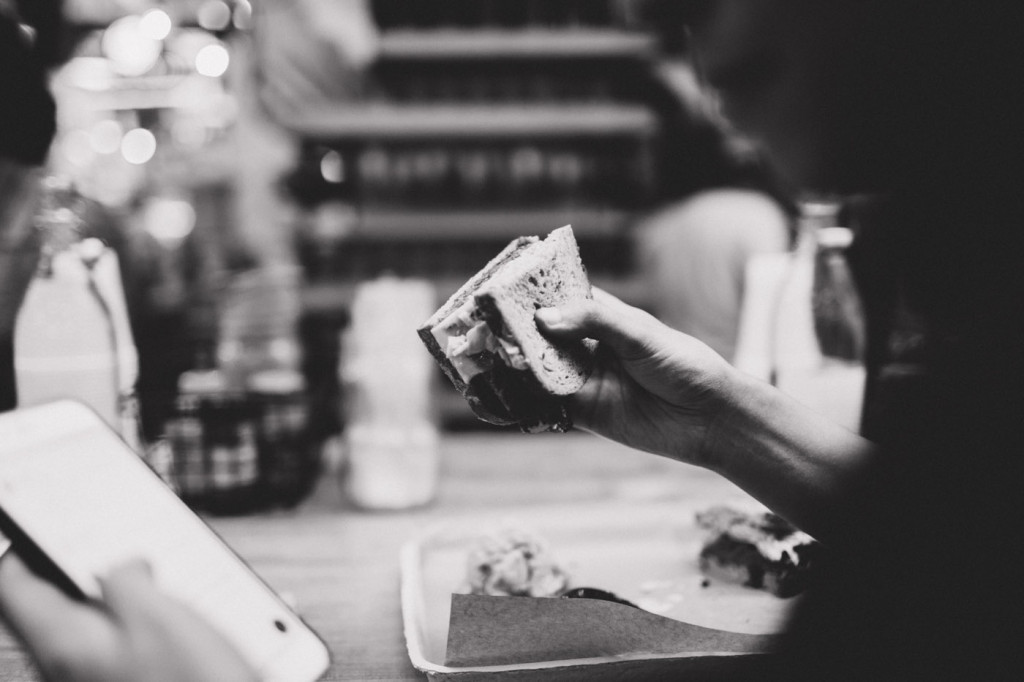

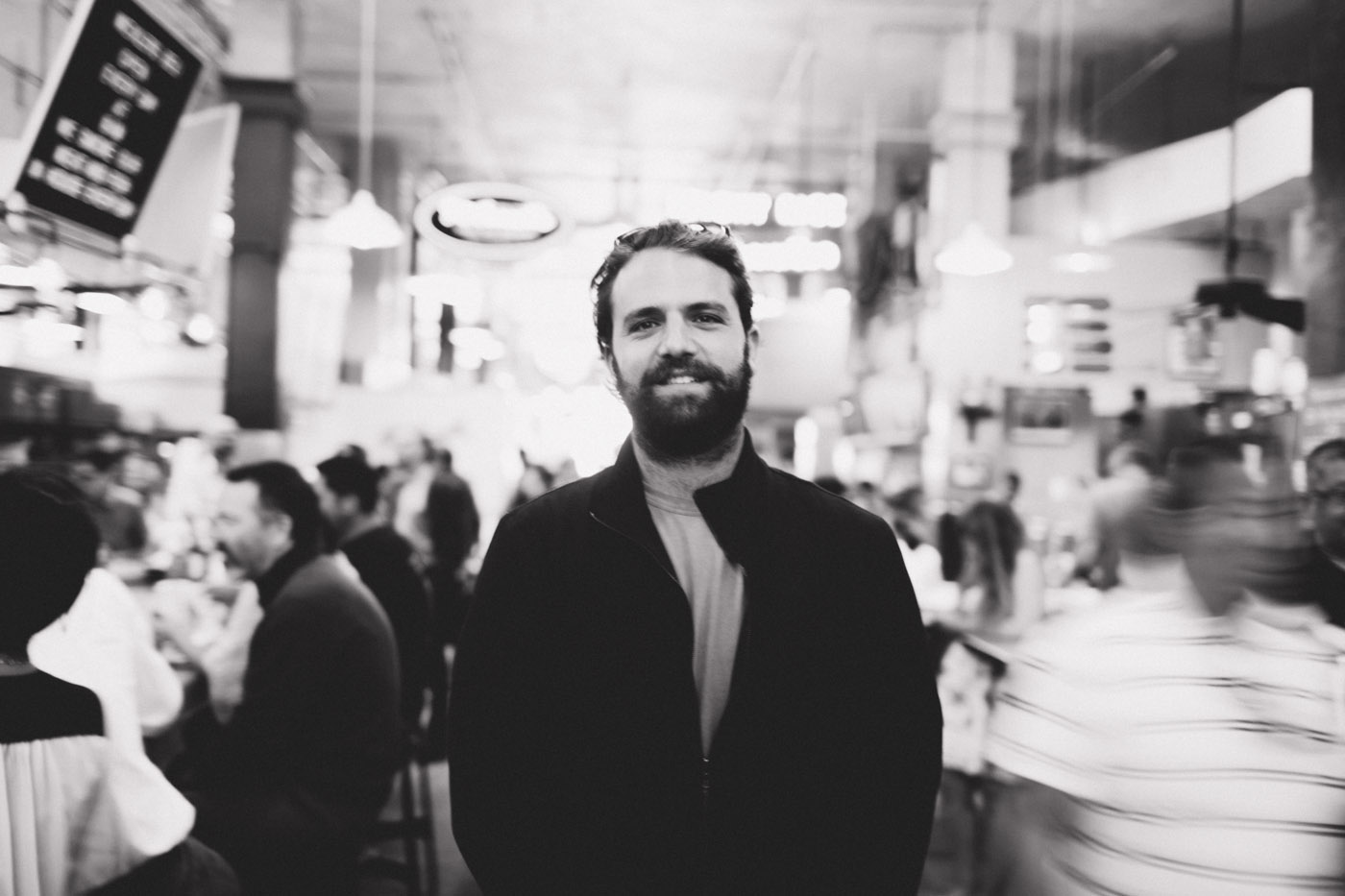
2.
Etchea Bakery is tucked inside a group of warehouse buildings adjacent to Hawthorne’s airport expansion. Its neighbors include a company that produces electric cars and another that creates rockets and spacecrafts. There is something uniquely American about this collection of old-world craft and future-leaning industry. The proprietors behind Etchea Bakery, brothers Charlie and Jean Baptiste Garacochea, are seventh generation bakers, descendants of a lineage that that hails from foot of the French Pyrenees mountains in the Basque region. The Garacochea family has been baking long before Jean Baptiste Garacochea moved to the United States in the early 1900’s.
But this is where this story plants its seed. Jean Baptiste brought a generational vocation with him to the United States. He used this skill, along with centuries old recipes and techniques passed from father to son, to create Pioneer French Baking Company in Venice in 1908. Seven generations later, after expansions and losses, successes and failures, and even the changing of hands, stands John Baptiste, the current iteration of the storied Basque baking family.
“After we sold the business,” John tells me, “we waited for a non-compete agreement to expire.” When that five-year period ended, the ovens were flipped back on and they made sourdough once again. Etchea Bakery was founded, or perhaps the French Bread Association reborn.
John introduces me to his brother Charlie, who runs bakery. An older man enters from the production area; this is Salvador, the chief baker at Etchea, who has worked with the Garacochea family for forty-one years, including experience during the Pioneer days.
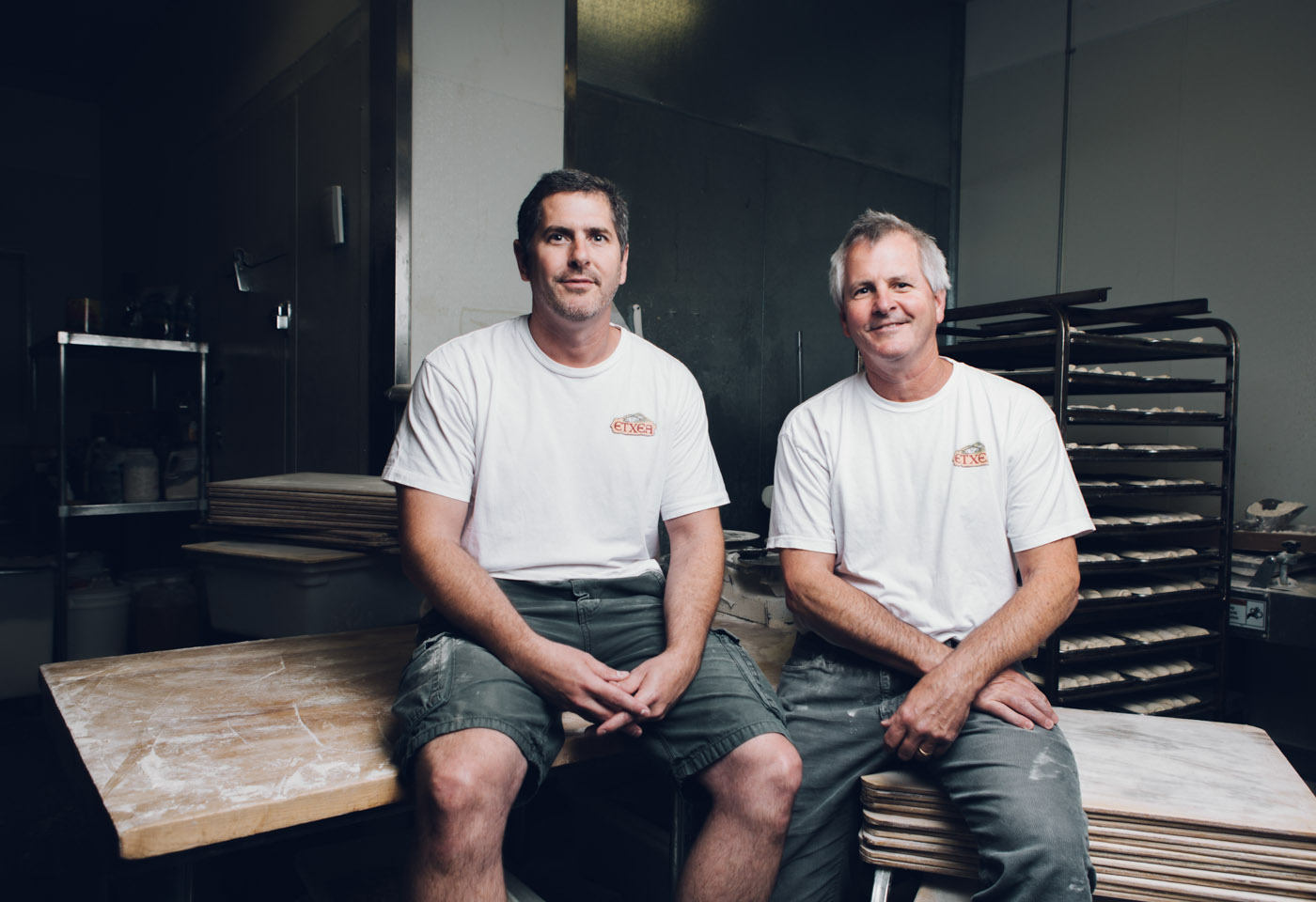
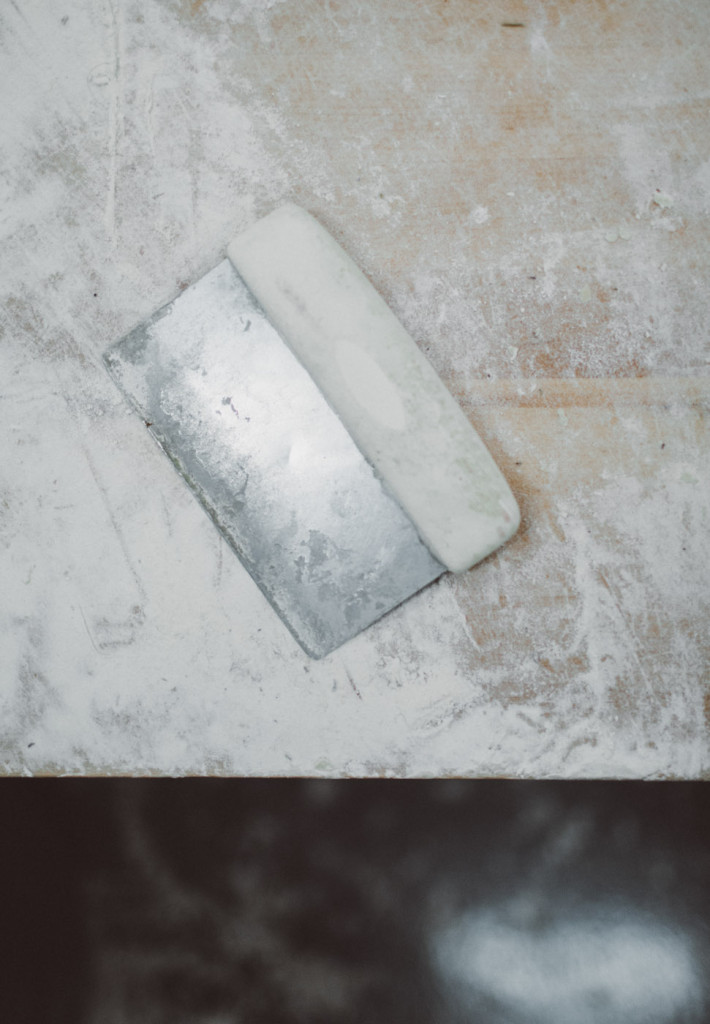
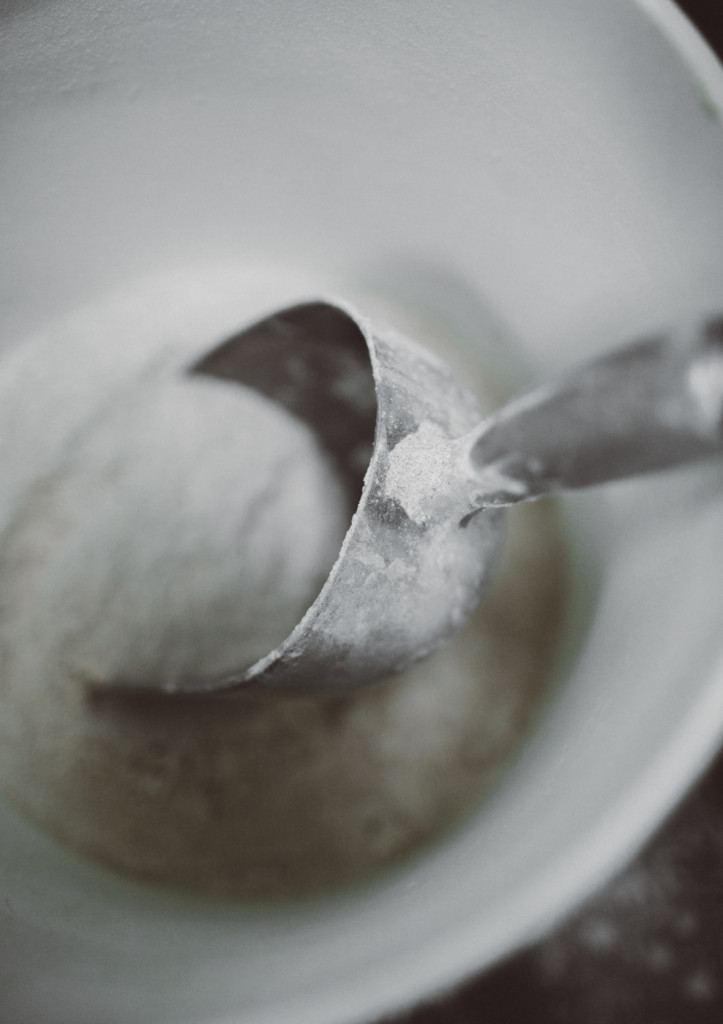
The lobby at Etchea Bakery is reminiscent of a living room. It’s easy to forget that this building is a full-scale bakery and that a few hundred yards away, actual spaceships are being manufactured. Instead, you sit on beautifully upholstered armchair and take in the slight scent of fresh bread each time the backdoor opens.
John Baptiste’s desk is near the entrance, and on the adjacent wall are photos and newspaper articles, sepia-toned pictures of people in long-outdated clothing in front of what was once Pioneer French Baking Company building. “This is a picture of the original bakery in Venice,” he tells me. “This is my grandfather Jean Baptiste.”
As John shows me photos of his family home and the original Garacochea bakery nestled in the French Pyrenees, a car parks in front of the glass window of the lobby. Two men emerge; it’s Wexler and Kassar. John, always amicable, introduces us and returns to his daily tasks, phone calls and emails, the logistical side of the business.
Wexler and Kassar are classmates from Cornell University’s School of Hotel Administration. They met freshman year over a miscommunication. “I saw him [Wexler] limping and I was thought, ‘Are you imitating my walk?” Kaiser says, and they laugh. The two have been friends since; they teamed up through college on multiple projects, and “catered a lot of frat parties.”
Afterwards, they again worked together in Europe for a year. First in Italy, and then at Restaurante Martín Berasategui, a famed three-Michelin star restaurant in San Sebastian, Spain. For a time, while cutting their culinary teeth, Kassar was front of house at Spago and Wexler ran the kitchen at Craft. In 2011, they collaborated as business partners as owners of the Mediterranean-themed Mezze in West Hollywood. After Mezze ran its course, they opened Wexler’s Deli in 2014.
“We talked about doing business and having a restaurant together; it was a natural pairing. You don’t find that often, to have a back of house person and a front of house person,” Wexler says. “One of the questions I get the most often chef friends trying to open their own thing is ‘How did you find Mike?’ So many people struggle to find someone they trust, who is actually good at what they do. We fight like crazy, but it allows us to have so much success.”
I ask about Seder. About brisket, tradition, about being Jewish, about not being Jewish, and they both laugh, understanding where I’m headed with this line of questioning. “I’m Jewish,” Wexler says, “Mike isn’t. But both of us had a real attachment to Jewish deli food growing up. Growing up in LA, deli food for Ashkenazi Jews is ubiquitous in every life cycle, whether someone is being born, getting married, a bar mitzvah—whatever the fuck it is, there’s always deli bagels and lox. If my mom wasn’t cooking and we were going out, it was always deli food. It’s comfort food.”
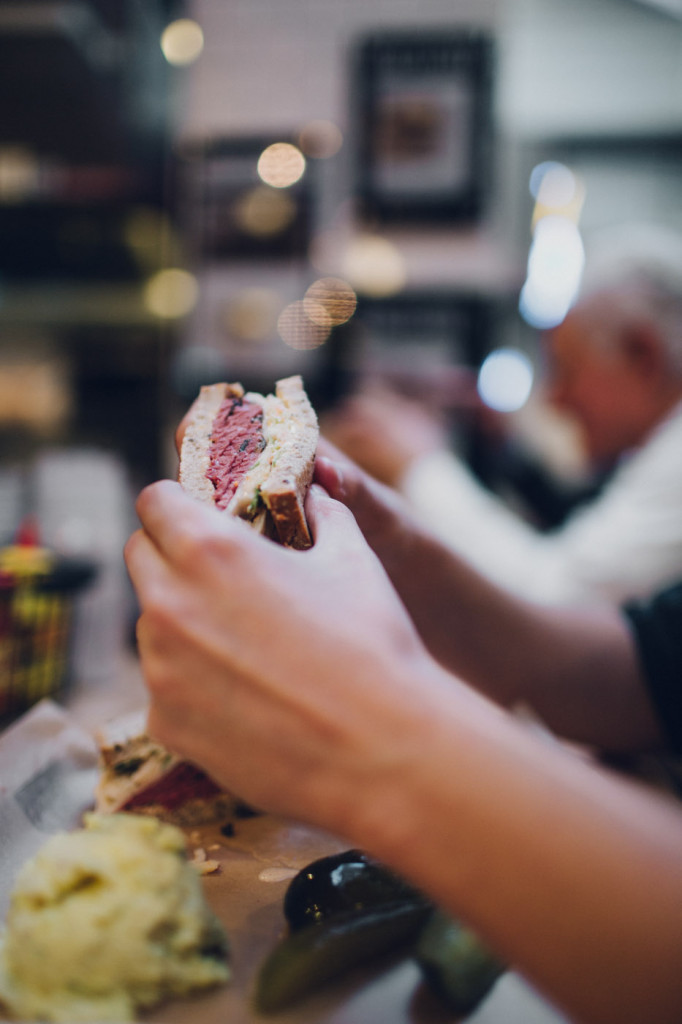
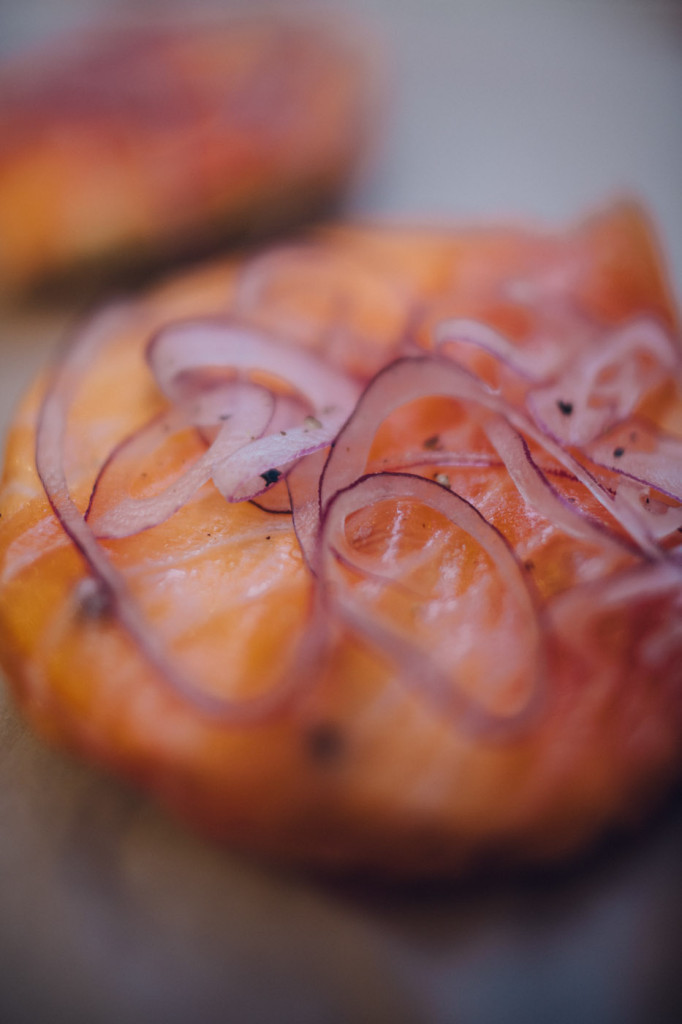
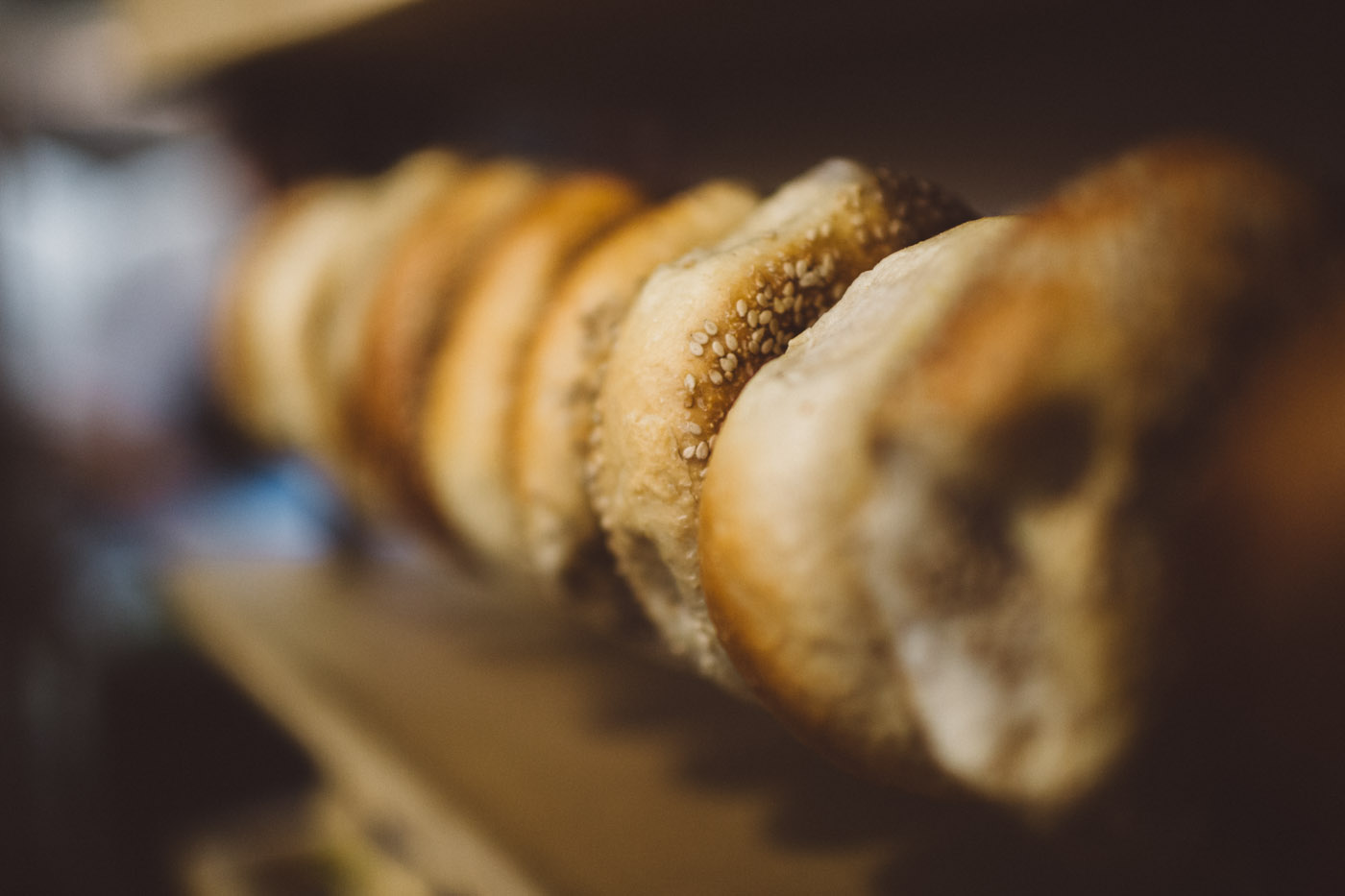
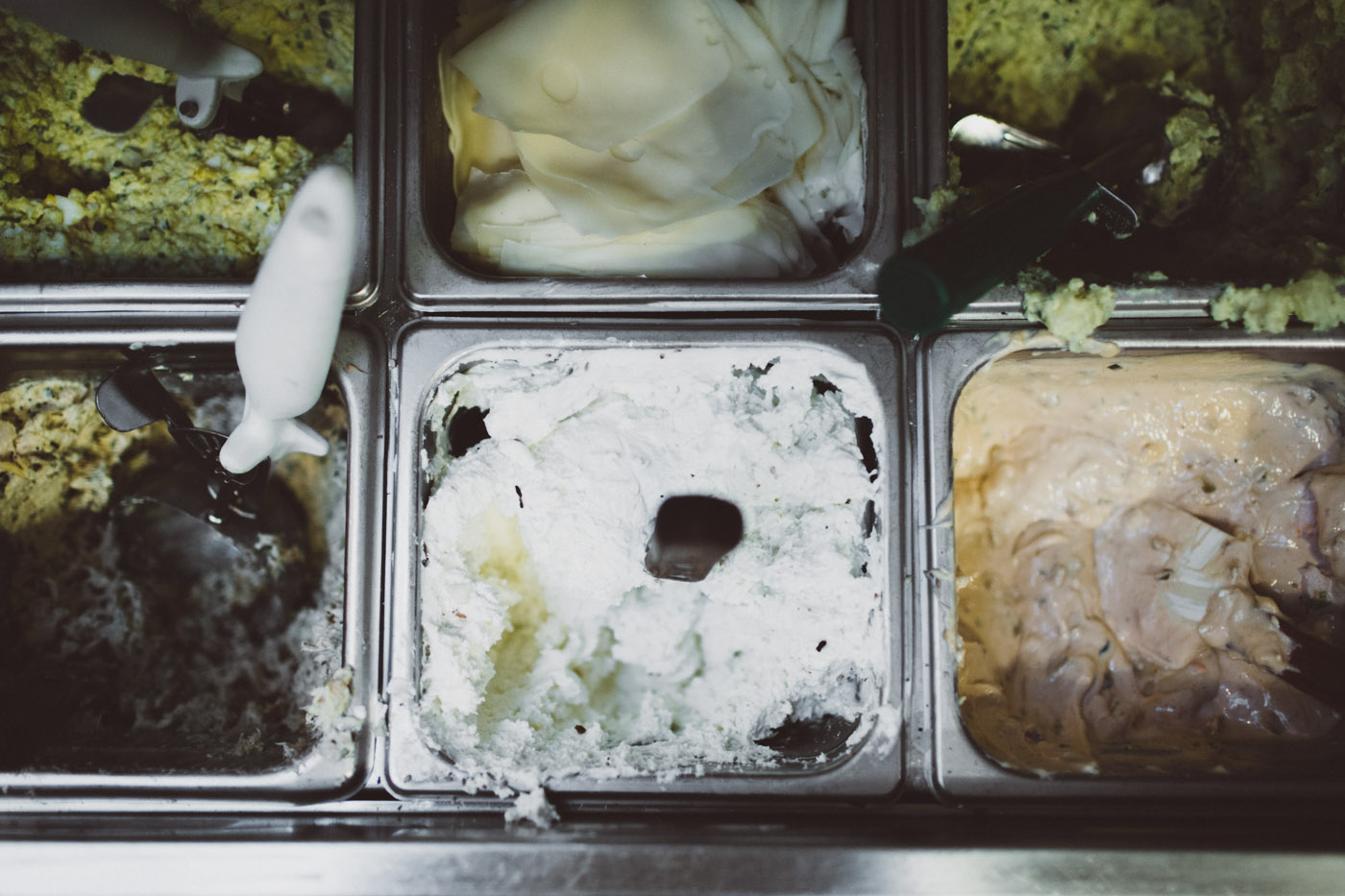
For Kassar, who was raised in Manhattan, deli food was part of the New York essence. “I went to high school on the Upper West Side,” Kassar says. “There was Zabar, H&H Bagels, Barney Greengrass. And I’m not Jewish, so I had a slightly different relationship to it, but some of my earliest taste memories are New York City bagels, matzo ball soups, knish. It takes me home as much as anything else.”
“This is the part I love about it,” Wexler says. “That it means as much to him even though he isn’t Jewish. America is a great country that way; there’s not necessarily a specific American cuisine, because so we’ve adopted so many others. In many major American cities, for people from all walks of life, with different economic levels, different ethnicities––deli food means so much to all of them.”
This idea makes me realize that each of us has a different relationship with Jewish food; this is the best aspect of American culinary culture represented in our current microcosm.
I ask how the partnership with John and Charlie came to be. “If you grew up in LA,” Wexler says, “you knew Pioneer Bakery sourdough rolls. They were my favorite as a kid, but one day they disappeared. About six years ago, I was working as a private chef in Malibu and stopped by a market. I saw a sourdough roll that looked just like the Pioneer; I bought it and ate it right there. I asked the guy ‘What is this Etchea Bakery? Where’d you get this?’ He says ‘Have you heard of the old Pioneer bakery?’ And I’m like––of course I have! That’s my childhood.”
“So I call them and say, ‘You don’t know me, but your sourdough rolls were a big part of my childhood,” Wexler laughs. “That started this whole friendship; we worked together for Mezze. Then we were thinking about the deli, and there were three elements: the meat, the bread, and the mustard. If one of those things is fucked, it’s over. I knew Etchea were the only ones who could do it.”
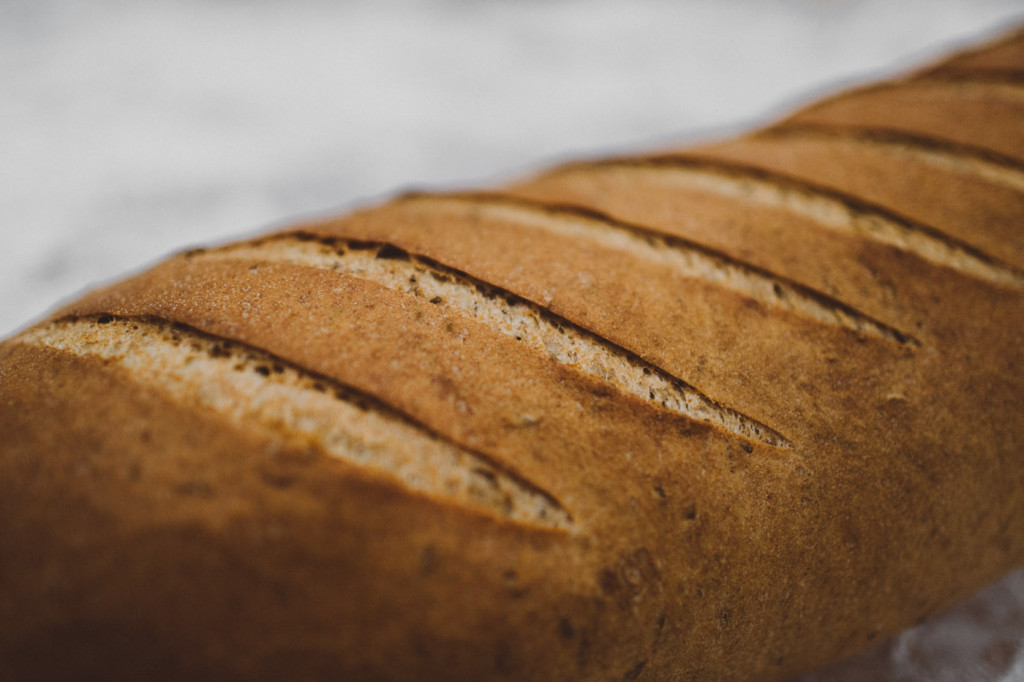
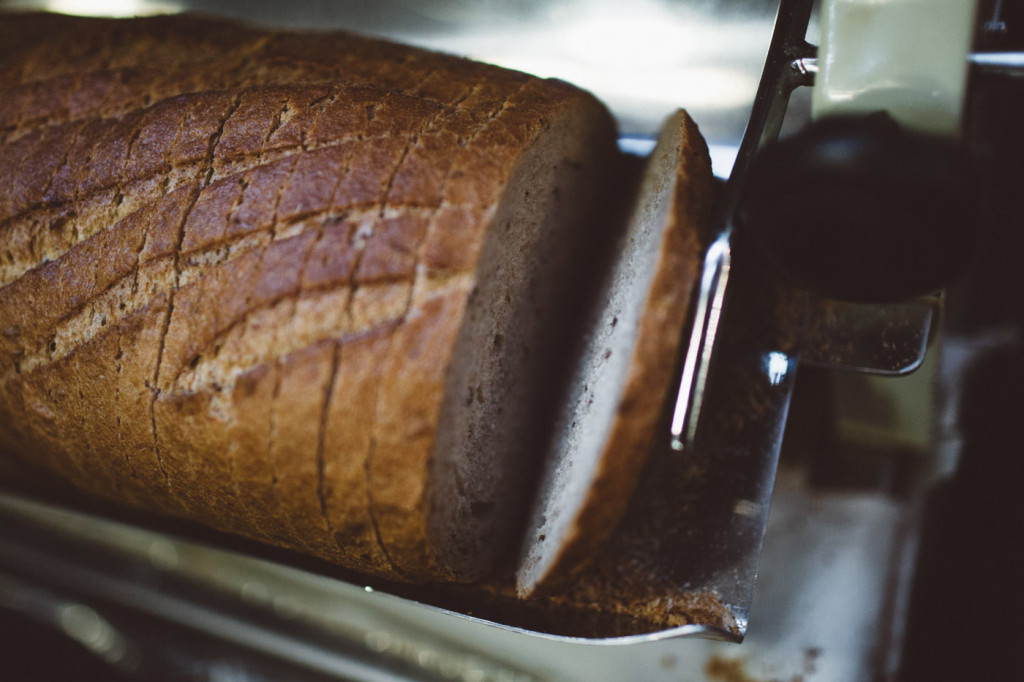
I ask if the bread was a collaborative effort between he and Kassar as well.
“I could ask my mom or my friend about something I cooked and they would say they loved it. But I ask Mike and I can tell what he’s thinking from the look on his face. In the restaurant there are very few people whose opinions you can trust. I got lucky with Mike. It was like that throughout the rye process.”
I wonder if building the menu was in the same vein. “Ours is like a greatest hits menu,” Kassar says. “From the first time he made the pastrami, he nailed it. The lox was there right away. We worked on the rye bread for a long time. The relationship is important for developing concepts; that’s a real collaboration between the two of us.”
“It takes a lot of research, a lot of tinkering,” Wexler says. “That’s how you make it the best. I don’t care that’s it’s a 350 square foot box and that we’re slinging sandwiches; I still want a fine dining mentality. There’s a methodology of how we put the sandwich together. We cure our meats in house. We make our pickles in house. Everything we do follows a method.”
“And if you eat a sandwich, it’s a singular experience,” Kassar says. “If the meat was good but the bread wasn’t, people are going to say they didn’t like the sandwich.”
I ask if it they’re paying homage to the deli experience, or if it is a more contemporary, elevated twist.
“It’s funny you say contemporary,” Kassar says, “because at its heart is a real old school Jewish deli. It’s traditional. There was like a fifty-year period when deli food became pretty bad. People thought of it as a bargain, like an all-you-can-eat buffet. People weren’t talking about whether the pastrami was good, but whether it was stacked as high as your head. It didn’t make sense. It’s too much food for one person, and it’s not a good ratio. We’re taking it back to what it was in the beginning, and we’re doing it in a location––Grand Central Market––that was one of the most historic food locations in LA. That’s where people were eating in the early 1900’s.”
“Originally,” Kassar says, “Grand Central Market was the place where people bought groceries. Downtown had its economic problems over the last forty years, and so did the market. People always want to throw their hands up over gentrification, but they’re not there.”
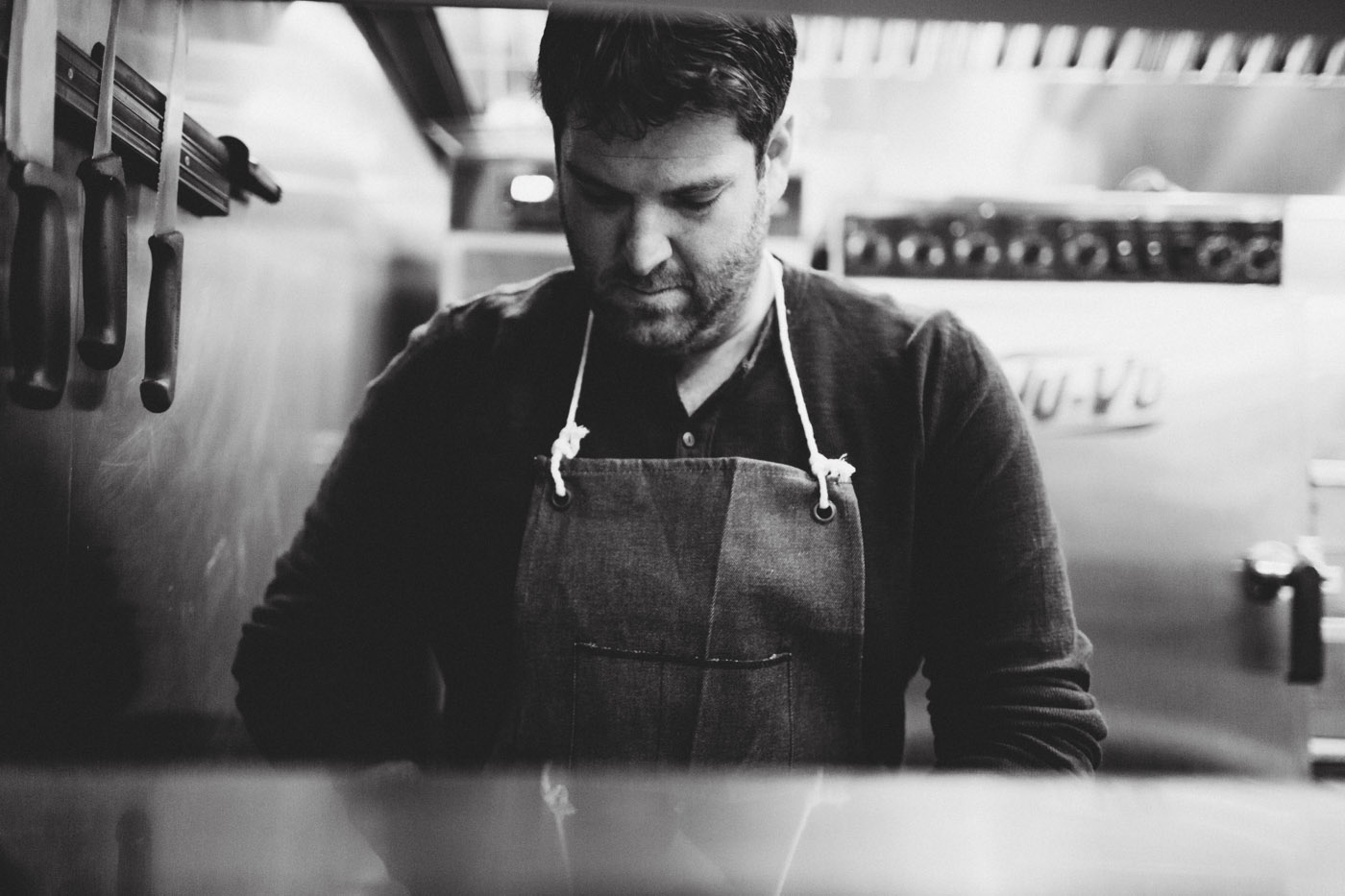
Wexler says. “Grand Central has a ninety-seven year history and at one point, it had four delis. For whatever reason, it has changed. So when you go back to that place and try to reinvigorate that history, that isn’t gentrification. This city is going through such a special process right now, everyone is trying to remake the city within their individual neighborhoods. Grand Central has become a microcosm for that. It’s an example for the rest of Los Angeles.”
“I think GCM did a great job with the renovation process. It’s small businesses, not just a bunch white dudes coming in and doing their thing and pushing everyone else out. It’s everyone.”
“And we’re creating the food we want to eat,” Wexler adds.
At almost any point in the day, the throughways between the vendor stalls are packed. An avenue of neon signs reads like a culinary guide to world cultures. It seems fitting that a Jewish Deli has found a place inside.
As our conversation leans toward pickles, and the pickling process and then nuances of mustard, John returns.
“Do you want to see how we make the sourdough?”
Of course I do.
3.
John and Charlie lead us through the backdoor of the lobby into the bakery. It is cavernous compared to the homey lobby, and there is that smell of baking bread; sweet and sharp, it is overwhelming. It’s doughy, yeasty perhaps, but it is evident that it is of sourdough rolls. One such roll appears and is passed to Wexler, then to Kassar and then to me. Right from the oven. As we pass through plastic strip doors, the temperature changes, and on the left are enormous industrial strength ovens. “That oven is Italian,” John points out. “And this one is from Germany. The stone hearth is important to baking rye bread. It holds the heat and gives the bread a better crust.”
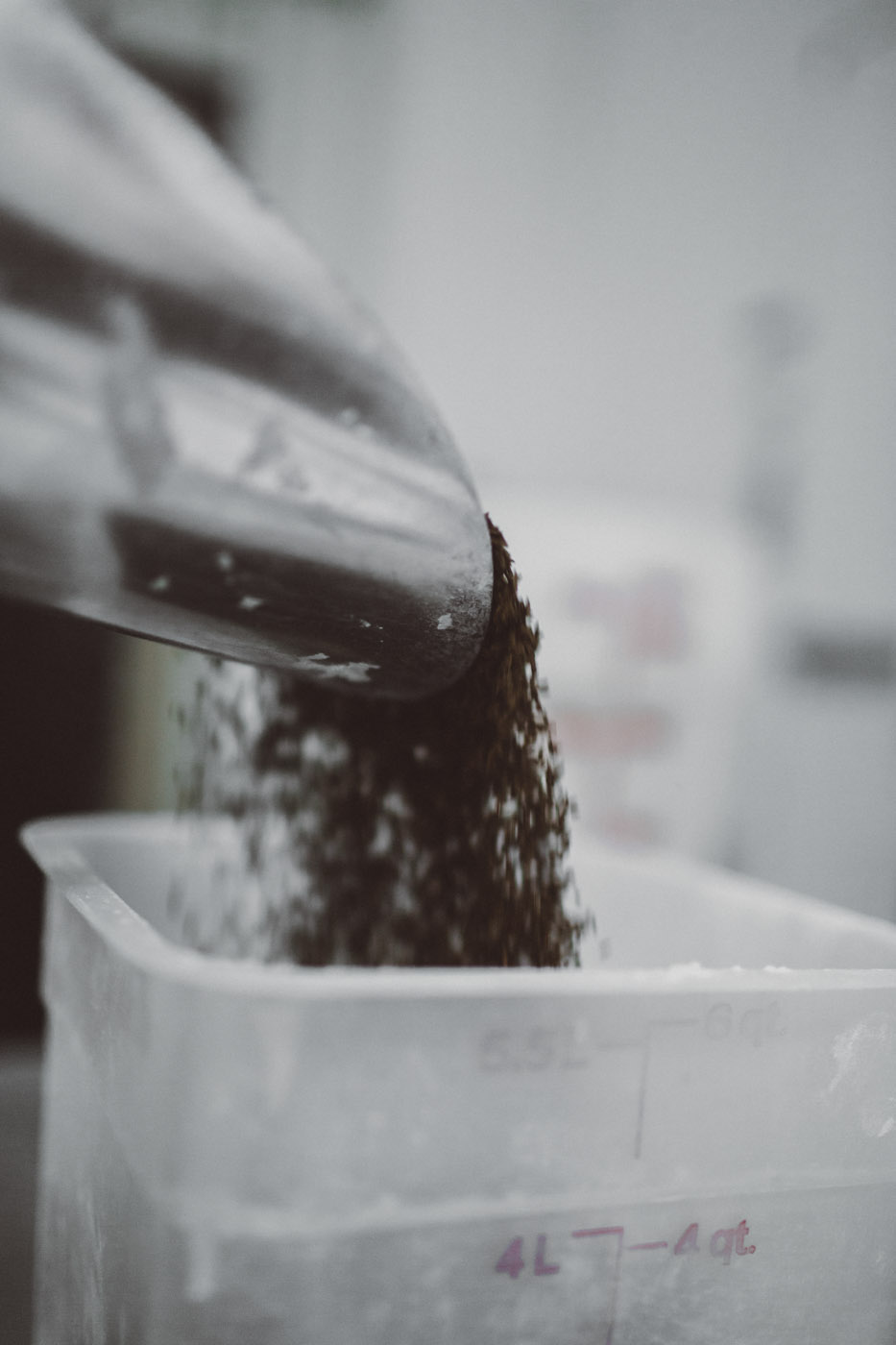
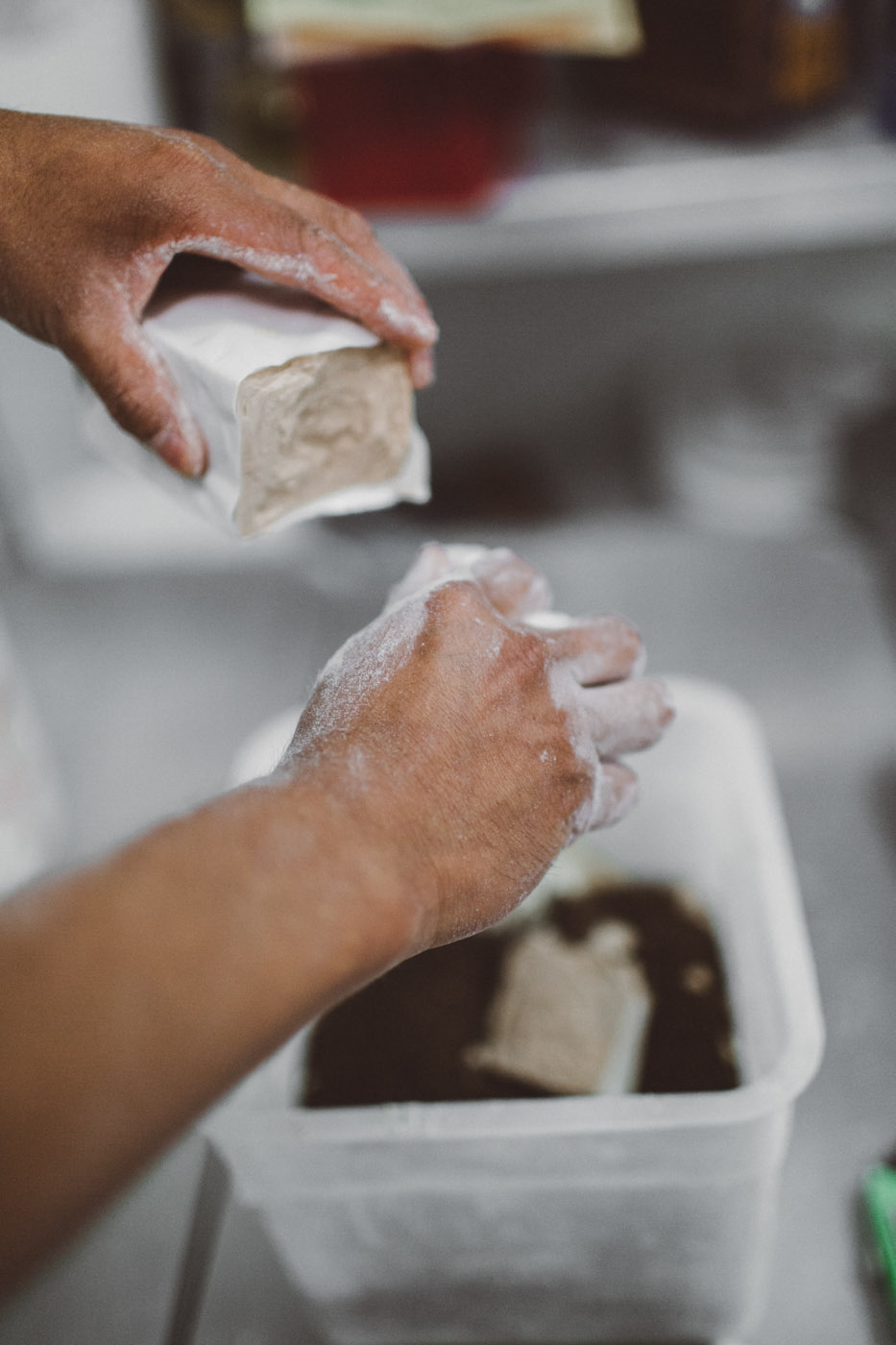
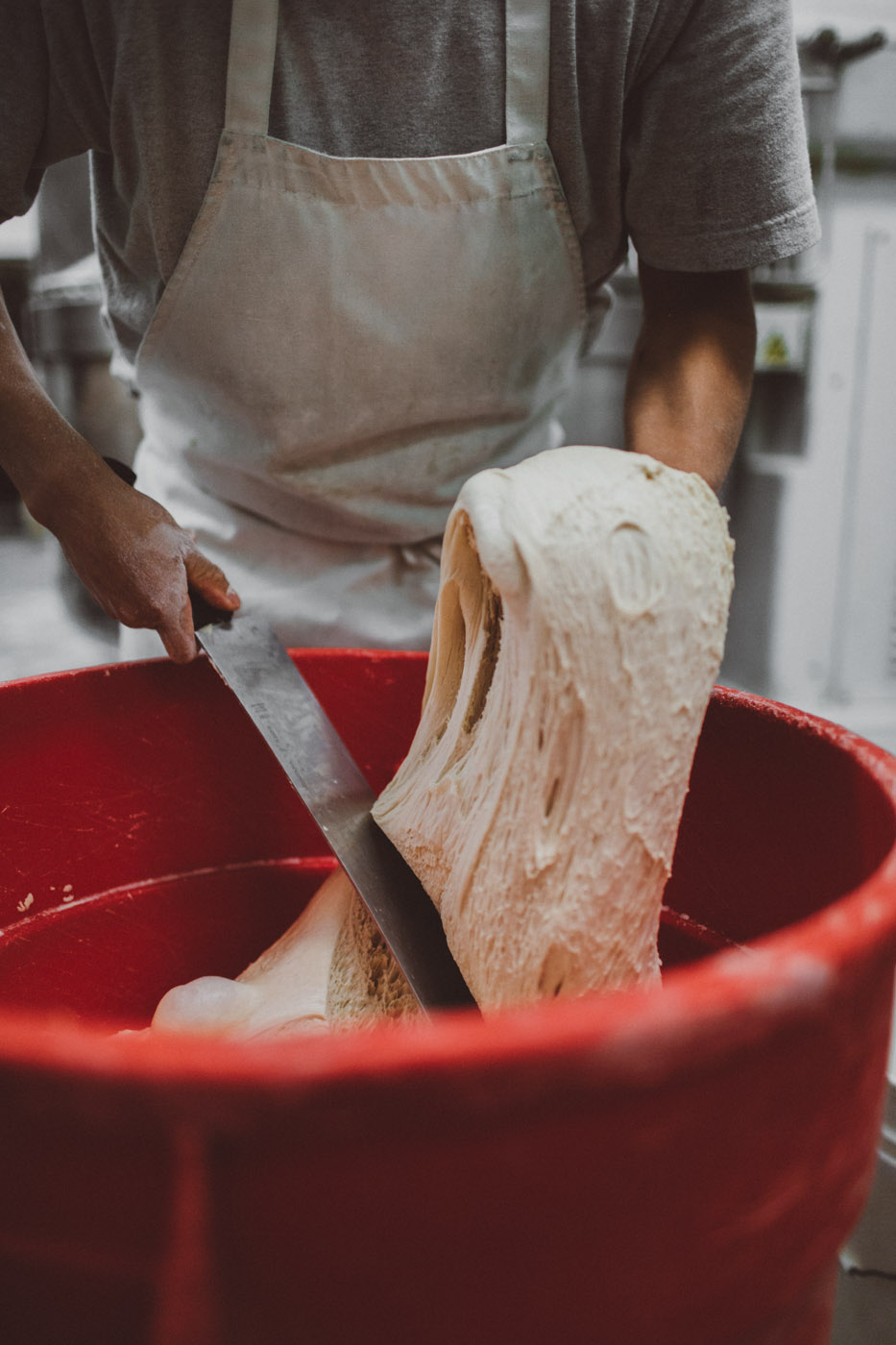
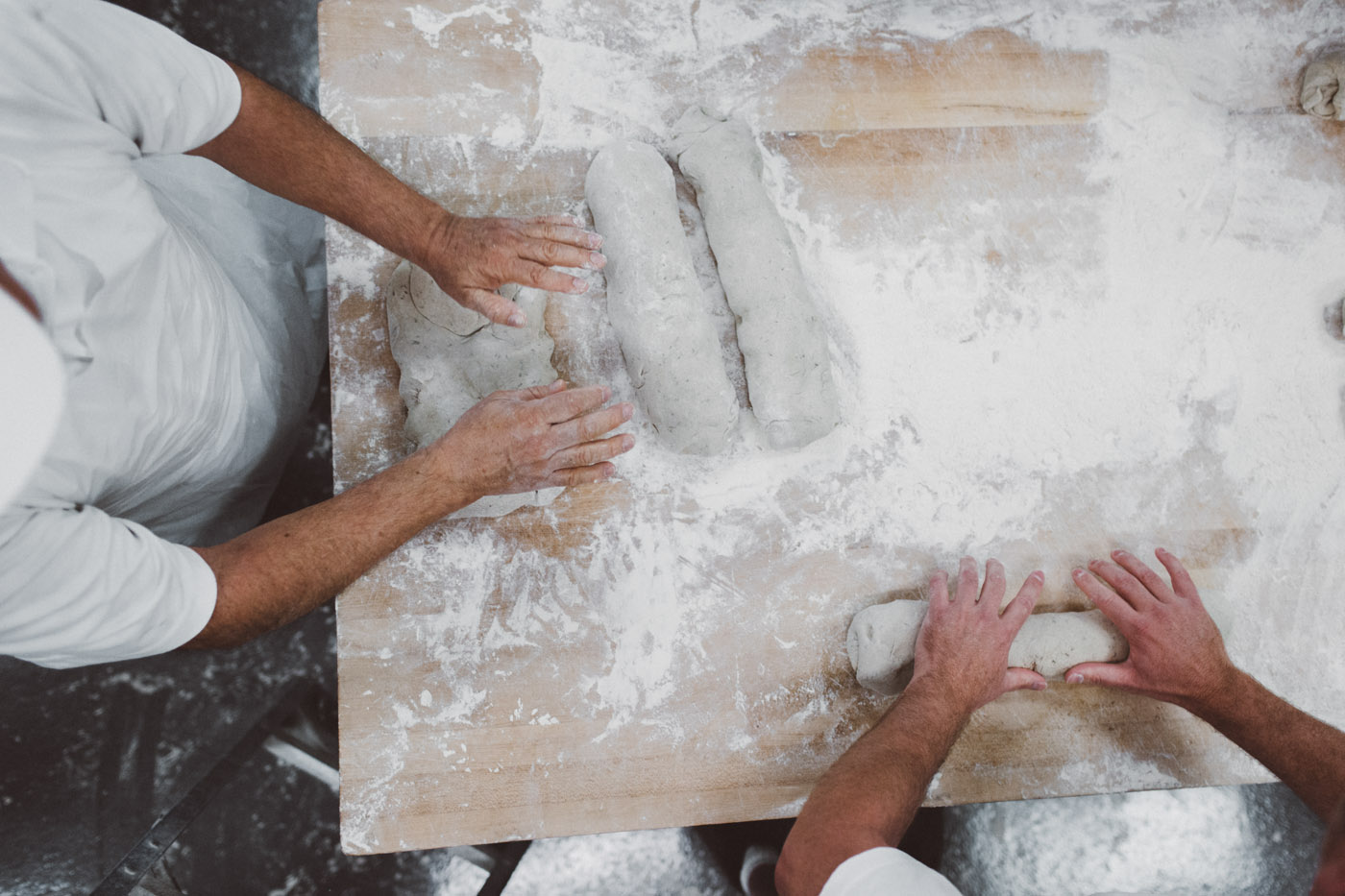

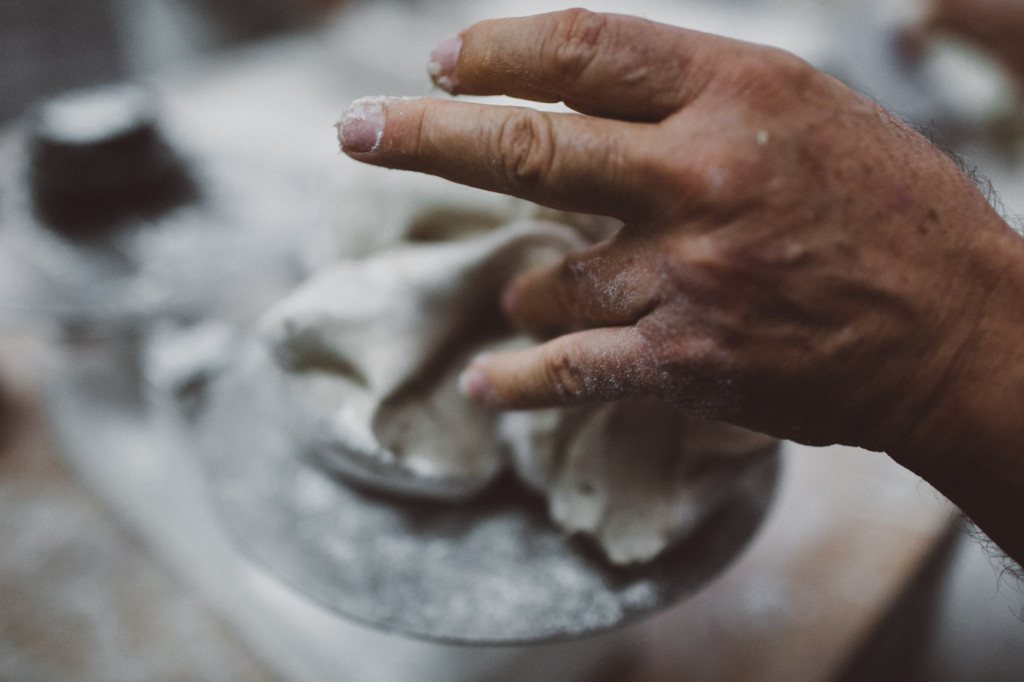
Charlie consults with a small production team as they load an oven with a rack of uncooked bread. This is the rye bread they make for Wexler’s. Wexler tells me they make it daily, just for the deli.
“I’ll show you where we keep the dough,” John says. We enter a refrigerated room, where Salvador is kneading dough on a table. “Mixing is the heartbeat of the bread,” he tells me. It is clear in Salvador’s deliberate, fluid motions, that he is a master baker.
“This is something you might like to see.” John brings me to the far corner of this room, in which a commercial refrigerator door is kept firmly closed. He opens it and rolls out a large, wheeled barrel with a damp cloth draped across. “We call this amatxi,” he says. “That means grandmother in Basque.” He uncovers the barrel and inside is a thick, porous liquid that more or less resembles the thing that bread dough becomes. This is the sourdough starter––or mother dough––as it colloquially called. “It’s been in our family for three hundred years,” John says. “When my great grandfather left the Basque, he brought this little bit with him from his father’s bakery. We feed it everyday.”
The starter dough is a pre-fermentation mixture made from wheat flour, water, and yeast. The older the starter, the better. “Are you showing him the grandmother?” Kassar asks from across the room, and they laugh. The mother dough is truly old world amongst the commercial machinery and giant ovens.
After we watch Salvador and his team knead, we return to the room with the ovens. The rye––Wexler’s rye––is almost ready. When they unload the oven again, heat escapes as the doors shutter open.
They place the finished product onto a bread rack. “Look at this crust,” Wexler says, pointing at roll. “You always want this even ring around the bread. That’s what makes it a perfect sourdough.”

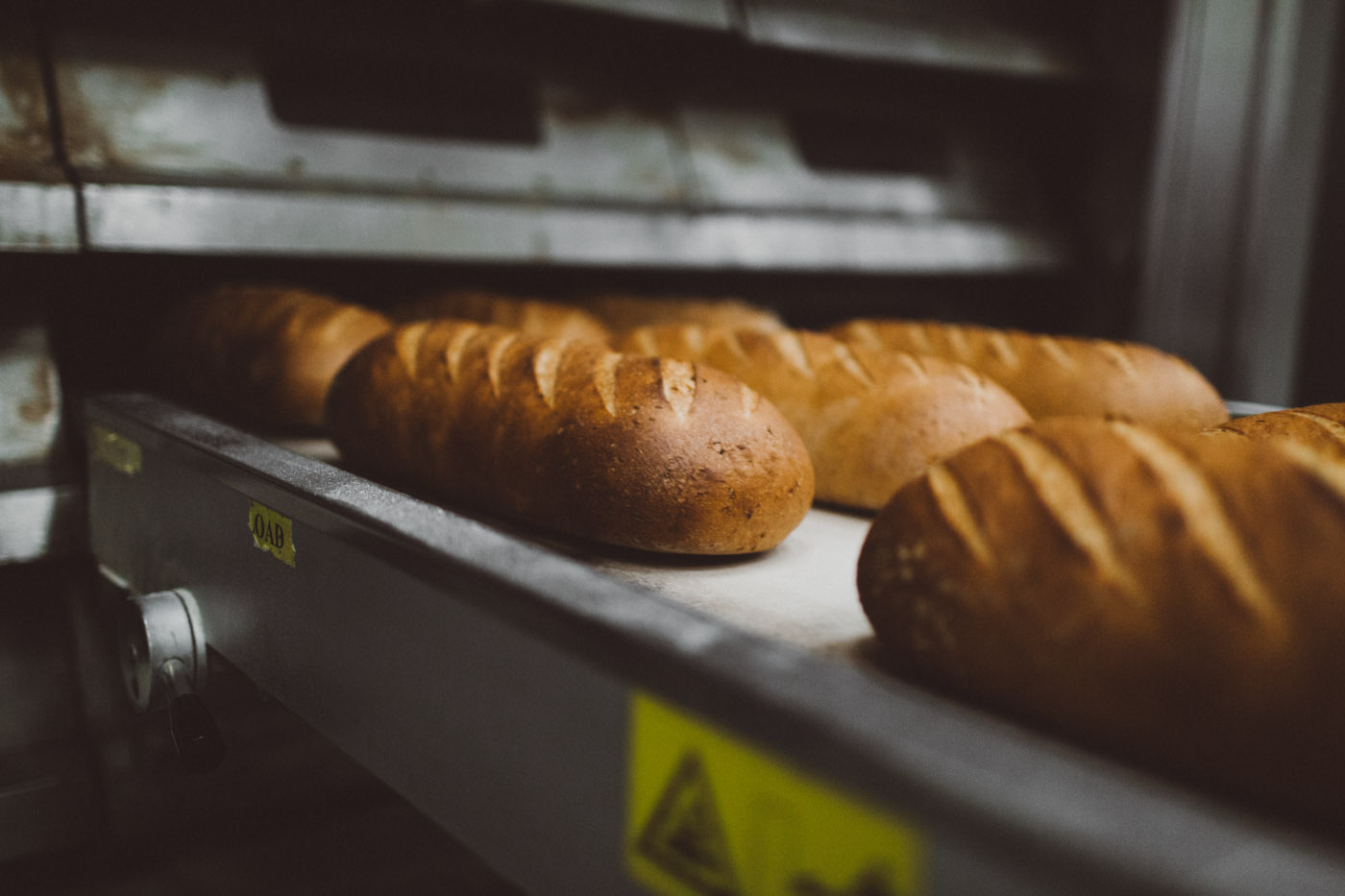


4.
We conclude the day at Wexler’s in Grand Central Market, the titular deli in this particular story. It is around noon and the lines for almost every vendor stall are long; Wexler’s is no different. The deli, which as Wexler mentioned, is about 350 square feet, is compact but lined in every direction with those eating and those waiting to eat. Inside their stall is a support beam for the entire market. They’ve lined it with spices. The backsplash tile decorating the exterior of the deli is reminiscent of authentic subway tile. Line drawings, words, and slick graffiti have been scrawled across the tile. On the single door leading in and out, there is a simple Star of David.
Kassar is the first to arrive. He emerges from the behind the counter where he has been directing traffic, stacks trays as they come in and observes each meal as it goes out. Wexler is also behind the counter now, wearing an apron. The steam wafts off the grill and the line of people move like clockwork. This is the tight ship to which Wexler referred; this is the method.
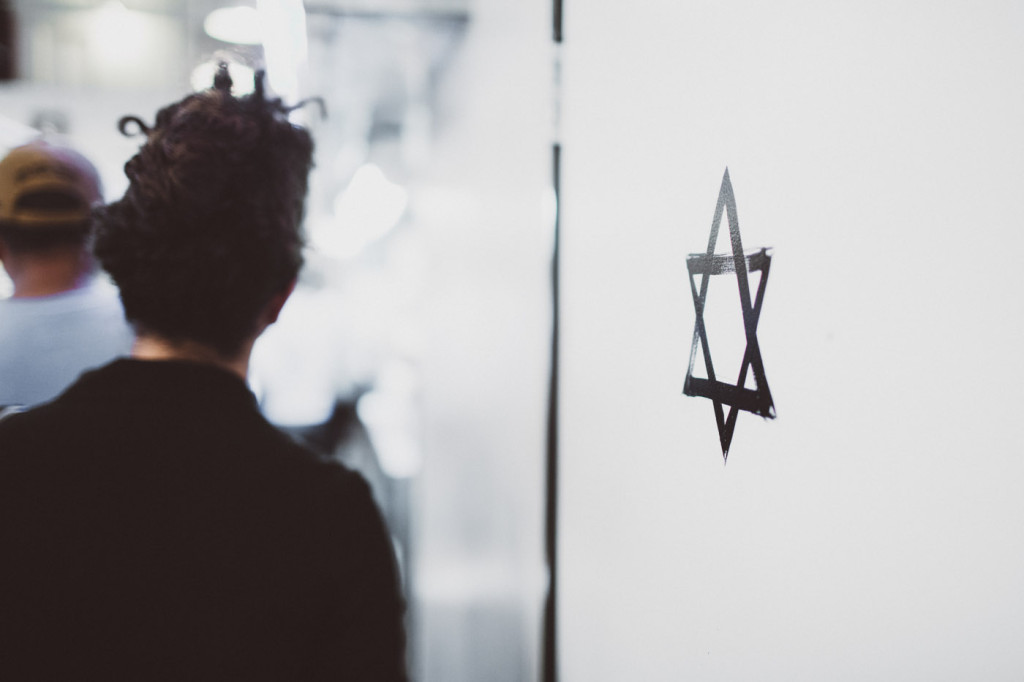
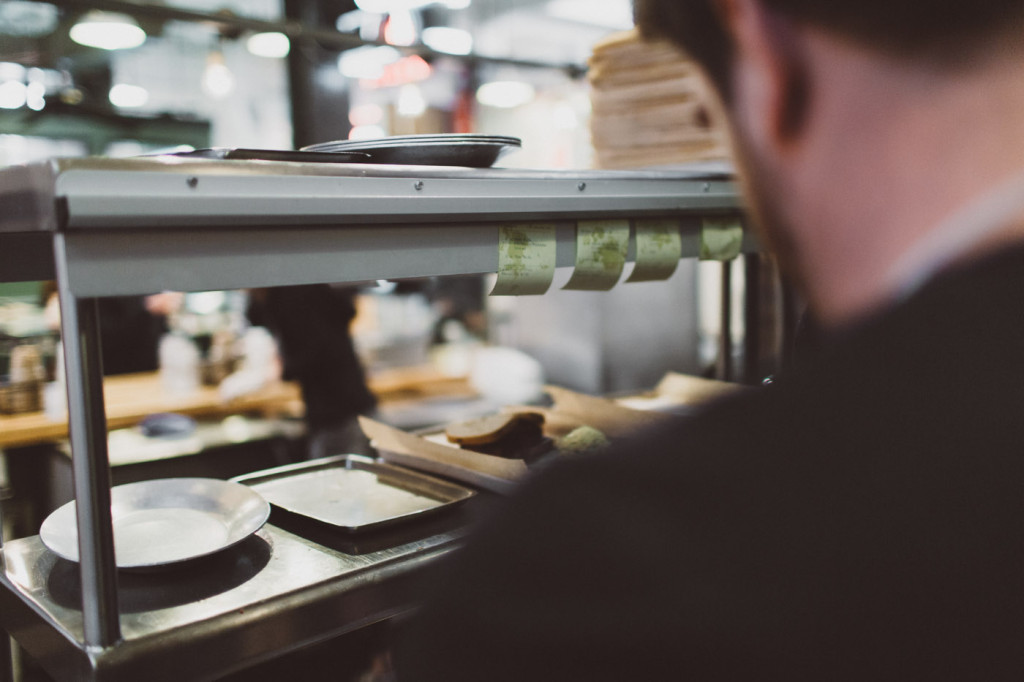
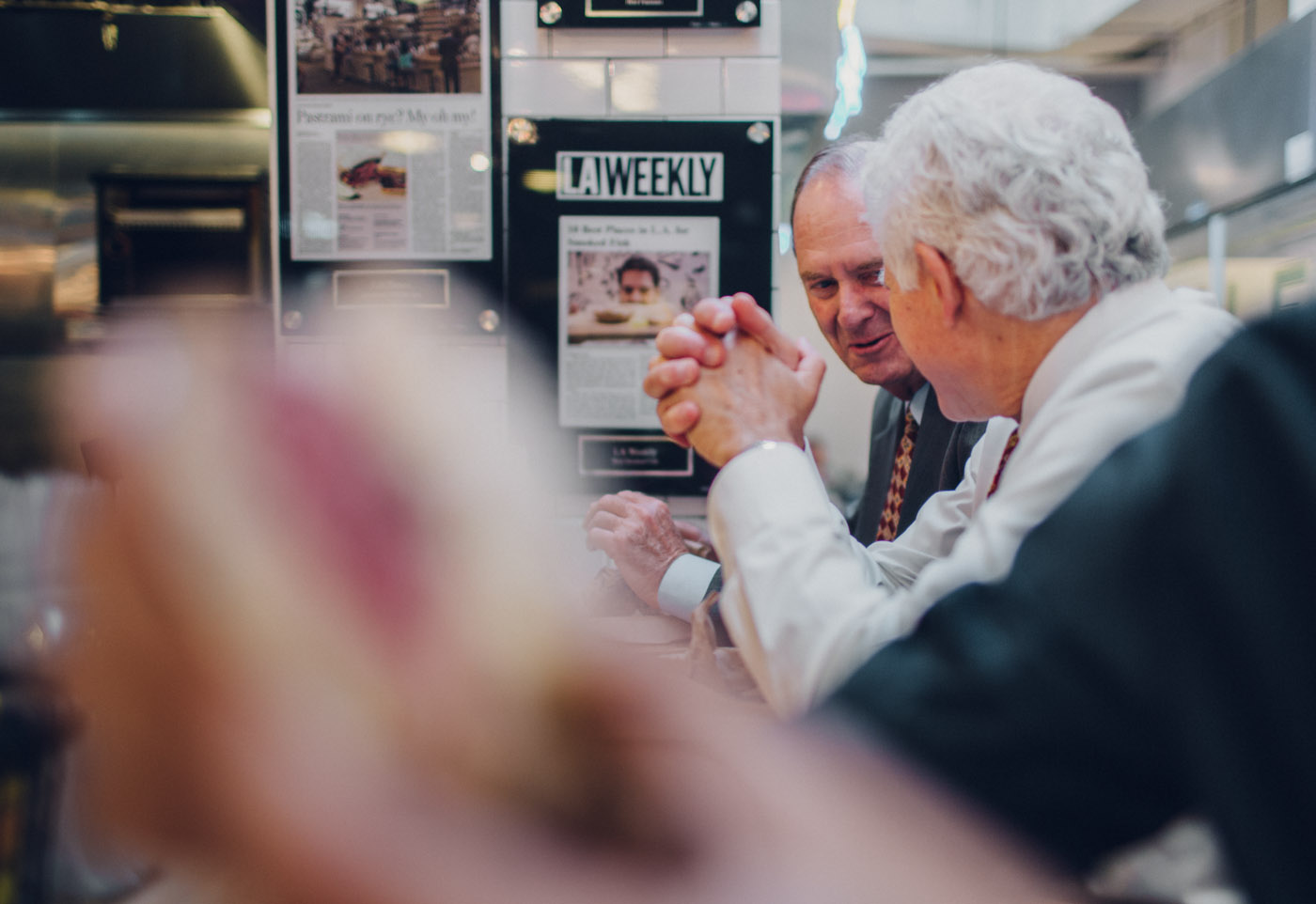
“You hungry?” he asks. “Let’s get you set up with a sandwich. Which one do you want?”
I leave it to his discretion. “We’ll get you the pastrami-on-rye,” he says. “This cut of brisket,” he says.
And there it is again, the brisket. The take away from Wexler’s Deli and Etchea Bakery is one of cultural synthesis, two distinct cultures and traditions converging to make one great meal.
One of the last things I see before leaving for downtown is the Garacochea brothers, Wexler, Kassar, and Salvador, all gathered around a pallet of flour bags, laughing. This is the week following Passover Seder and I’m eating brisket at a new, old-school Jewish deli run by two of the culinary world’s brightest stars––one Jewish and one not. Their bread is baked by two Basque bakers, seven generations deep, and above me are neon signs that boast menu items like Bombi and Roast-to-Go and La Casa Verde and Torres and Bento Ya. Really, what could be more American than a great meal?
—
Wexler’s Deli
317 S Broadway, Los Angeles, CA 90013





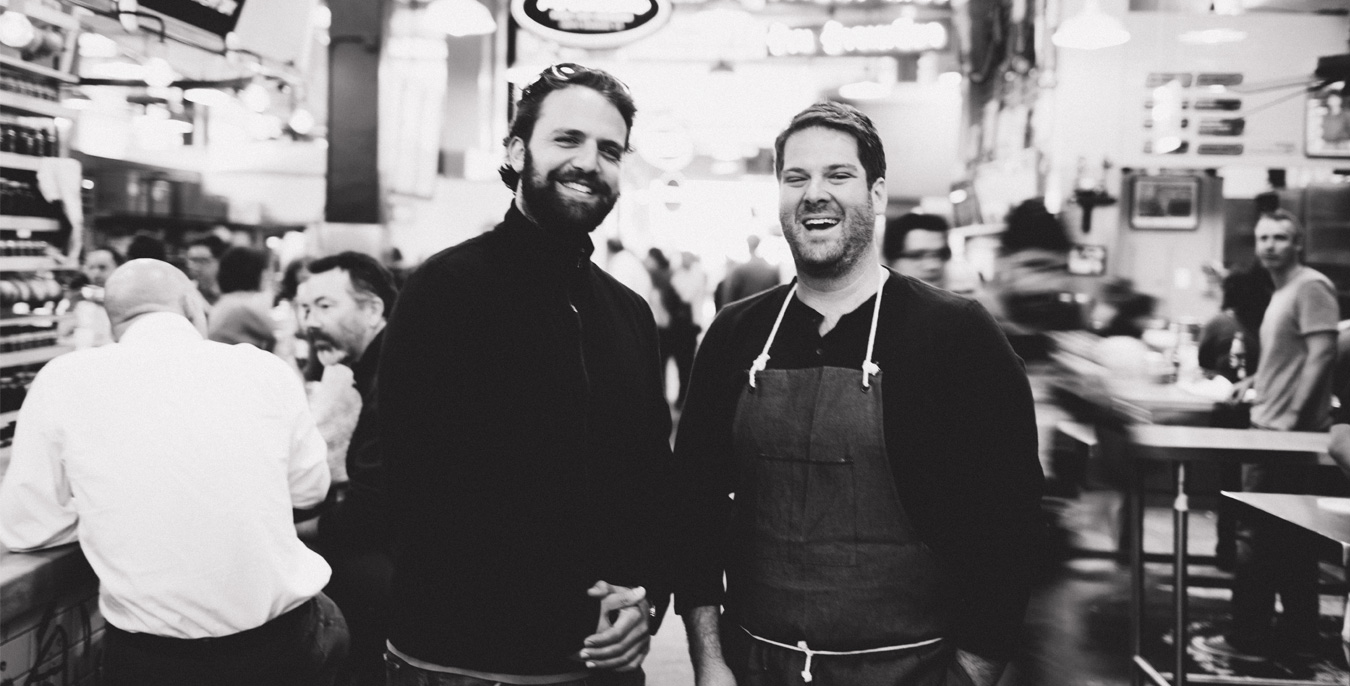

Our comments section is for members only.
Join today to gain exclusive access.